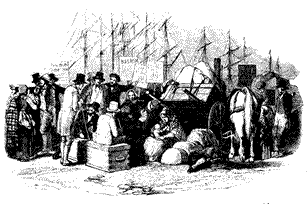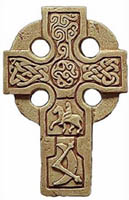The Leathem Diaspora

Notes of the emigration of Leathem/am/an/en/es/om/im Families around the world:
The name, whatever the spelling, was originally from the United Kingdom. It is not common when compared with other surnames in number. However, clusters of Leathem families appear across the map of Great Britain and Ireland. Larger numbers are located in Lancashire and North Yorkshire and further north in Lanarkshire in the Scottish Lowlands. If you have a detailed map of Great Britain and Ireland, you can find a "Upleatham" in Northern England and a "Leathemstown" to the East of Lough Neagh in the Belfast Hills of Northern Ireland.

Four hundred years ago, James I of England, who had previously been crowned James VI of Scotland, undertook what was one of the earlier examples of "social engineering" in his efforts to control the rebellious Irish. Inducements were offered to resettle Scots and English loyal to the crown onto lands seized in Ireland. Estimates of 100,000 Scots, lesser numbers of English and later some French Huguenots immigrated in the period between 1610 and 1717. No doubt, the migration to the Ulster Plantation initiated by King James I transplanted Leathems in Ireland. These were mostly adherents to the Presbyterian and Anglican traditions. However, Leathems are also found in the records of the Roman Catholic community. The greatest concentrations of Leathems were found in Counties Antrim, Down and Armagh in Ulster, NI. Others settled in what is now the Republic in Counties Donegal, Cavan and Monaghan. Many of them were tenant farmers, flax growers and linen weavers by trade. They played a part in the Industrial Revolution that was initiated in the textile industry in the British Isles during the eighteenth century.
Although many were to participate in the emigration during the 1800s to America and parts of what was then the British Empire, currently there are about seventy Leathem families in Northern Ireland. The greatest numbers of these were and are still found in the valley along the River Lagan and the Lagan Canal. To this day, the Northern Ireland phone directory contains numerous Leathem listings for Belfast, Lisburn, Lurgan, Waringstown and Downpatrick.
Although not common today, one of the earlier variant spellings of Leathem is Leathes. In the early history of the Ulster Plantation, numerous members of the Leathes-or Leathem-line played a role in the daily life of Belfast serving as sovereign (mayor) or a prominent burgess. On March 8, 1638, John Leathes became sovereign of Belfast. later, in the century that followed, a father, William Leathes, his son John and his grandson Robert were sovereigns of the town in succession. In 1699, according the the Ulster Journal of Arcaelogy, volume 4, 1856, page 270, Leathems were still ranked among the principal families of Belfast.
Leathems played a role in the settling of the New World. Leathems reached the United States by direct emigration or through Canada in the 18th and 19th centuries. Most of these came from Ireland with lesser numbers from Scotland and England. This was largely attributable to the economic, political and religious issues that disrupted Irish life at that time.

Along the way, the family name has been lent to things trivial and profound. There is a Leathem Cottage which may well be the oldest continuously occupied home in Belfast dating back to 1786. If you are a scientific type with a penchant for electromagnetism, check out Leathem's Phenomenon (1913). A self taught English artist, William John Leathem (1815-1857), who was born in London, painted the huge two by four meter canvas depicting the Battle of Trafalgar (1805) as seen above. He made his permanent home in Brighton in 1840 and the painting now resides in the Brighton Museum and Art Gallery. Cruising the web, you'll find athletes, teachers, scholars, lawyers and business people not to mention a few genealogists who bear the name.
Shortly after the Revolutionary War, there were Leathem families here in America in upstate New York, Pennsylvania, the Delmarva Peninsula, Virginia and the Carolinas. Today, the surname can be found in most states with larger numbers apparent in the Northeast Corridor, North Central Ohio, Florida, Kentucky, Louisiana, Utah and California. An estimated 160 Leathem families are found in the United States: more if you allow for variant spellings. When you include the spelling "Leatham," the number doubles. This is particularly true in Idaho, Utah and nearby Western States where a large Mormon Community brought this spelling directly from Scotland. If you add the "Lathem" spelling, particularly in South Carolina, Georgia, Alabama, Mississippi and Texas you'll see a similar increase. Other variant spellings increase the total still further.

Our branch of the family has origins with James Leathem, a tenant farmer, in the early 1800s in County Antrim, Ireland. He lived in the townlands of Killyless and Loan in the Parishes of Craigs/Ahoghill just west of Cullybackey along the Main River. His son Samuel married Hannah Dodds in 1859. Years later they emigrated, piecemeal, through the ports of Larne and Cobh (Queenstown) and landed in New York City in the early 1880s. They moved up the Hudson River to the Albany/Troy area. As tenant farmers, they settled along the Brunswick Road near the Quackin Kill, a stream in Brunswick, NY. At the time, it was a small town just outside of Troy, with a population of about 3400. Later, like so many other families, some of their children resettled across the country. Within the next ten years, Samuel, Thomas and Joseph went out to Colorado to try their hands at being cowboys but none remained. After the turn of the century, Thomas moved to Bloomfield Connecticut where he continued to farm. About the same time his siblings Mary, Anna and Robert moved to the Los Angeles area. Four other brothers and sisters, Joseph, a.k.a. James, Catherine, Hannah and John remained in the greater Albany area.
With the help from others, additional notes and comment on the movements of Leathem families around the world will be added to this site. We are seeking to secure genealogies; images and histories on those Leathems and similar spellings that went to Canada, Australia, New Zealand and South Africa in an effort to broaden the site content and would enjoy hearing from you.
